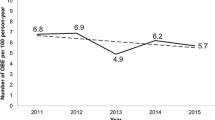Abstract
This review of last year’s literature on blood-borne pathogens (= pathogenic microorganisms that are found in human blood) focuses on hepatitis B (HBV), hepatitis C (HCV), and human immunodeficiency virus (HIV) as the most common pathogens, despite the fact that other microorganisms may cause blood-borne diseases as well. Since the prevention of blood-borne diseases is something that, in the past, has gotten a lot of attention and by now is fully integrated in all safety structures in the U.S., the recent literatures mainly have been come from resource-limited/developing countries and Europe (which, in the definition of the financial word at the present time, in some parts overlap).
Similar content being viewed by others
References
Papers of particular interest, published recently, have been highlighted as: • Of importance
• European Agency For Safety and Health at Work. Council directive 210/32/EU: implementing framework agreement on prevention from sharps injuries in the hospital and healthcare sector concluded by HOSPEEM and EPSU. Off J Eur Union. 1 June 2010.
Lazenby MG, Anderud J, Whitley SP. Blood-borne viruses: are we taking them seriously? A survey of UK oral and maxillofacial surgeons. Br J Oral Maxillofac Surg. 2011;49:400–3.
• Deuffic-Burban S, Delarocque-Astagneau E, Abiteboul D, et al. Blood-borne viruses in health care workers: prevention and management. J Clin Virol. 2011;52(1):4–10.
Li L, Lin C, Wu Z, et al. HIV-related avoidance and universal precaution in medical settings: opportunities to intervene. Health Serv Res. 2011;46(2):617–31.
Karim J, Al-Saraji M, Al-Mousawi F, et al. Knowledge and Self-Reported Practice of Universal Precautions among Kuwait University Medical Students in Their Clinical Years. Med Princ Pract. Jan 13, 2012.
Sreedharan J, Muttappillymyalil J, Venkatramana M. Knowledge about standard precautions among university hospital nurses in the United Arab Emirates. East Mediterr Health J. 2011;17(4):331–4.
Hosoglu S, Akalin S, Sunbul M, et al. Healthcare workers' compliance with universal precautions in Turkey. Med Hypotheses. 2011;77(6):1079–82.
Gönen I, Geyik MF. Percutaneous injuries among healthcare workers at a general hospital. JMID. 2011;1(1):26–30.
Raguse JD, Camerer C, Bergmann F, Schewe C, Schurmann D. Occupational Syphilis Following Scalpel Injury. Ann Intern Med. 2012;156:475–6.
Ghannad MS, Majzoobi MM, Ghavimi M, et al. Needlestick and Sharp Object Injuries Among Health Care Workers in Hamadan Province, Iran. J Emerg Nurs. 2011 Jun 2.
Kuruuzum Z, Yapar N, Avkan-Oguz V, et al. Risk of infection in health care workers following occupational exposure to a noninfectious or unknown source. Am J Infect Control. 2008;36(10):e27–31.
• Kessler CS, McGuinn M, Spec A, et al. Underreporting of blood and body fluid exposures among health care students and trainees in the acute care setting: a 2007 survey. Am J Infect Control. 2011;39(2):129–34.
Mir O, Adam J, Veyrie N, et al. Accidental blood exposures among medical residents in Paris, France. Clin Microbiol Infect. 2011;17(3):464–6.
• Patrician PA, Pryor E, Fridman M, Loan L. Needlestick injuries among nursing staff: association with shift-level staffing. Am J Infect Control. 2011;39(6):477–82. Epub 2011 May 25.
Anderson DJ, Miller BA, Chen LF, Adcock LH, Cook E, Cromer AL, et al. Sexton DJ; The network approach for prevention of healthcare-associated infections: long-term effect of participation in the Duke Infection Control Outreach Network. Infect Control Hosp Epidemiol. 2011;32(4):315–22.
Yang L, Mullan B. Reducing needle stick injuries in healthcare occupations: an integrative review of the literature. ISRN Nurs. 2011;315432 Mar 31.
van der Molen HF, Zwinderman KAH, Sluiter JK, et al. Better effect of the use of a needle safety device in combination with an interactive workshop to prevent needle stick injuries. Saf Sci. 2011;49(8–9):1180–6.
Parantainen A, Verbeek JH, Lavoie M-C, et al. Blunt versus sharp suture needles for preventing percutaneous exposure incidents in surgical staff. Cochrane Database Syst Rev. 2011;(11).
Haines T, Stringer B, Herring J, et al. Surgeons' and residents' double-gloving practices at 2 teaching hospitals in Ontario. Can J Surg. 2011;54(2):95–100.
Federal Drug Administration. Guidance for industry and FDA staff. Medical devices with sharps injury prevention features. Rockville: US Department of Health and Human Services; 2005.
Adams D, Elliott TS. Safety-engineered needle devices: evaluation prior to introduction is essential. J Hosp Infect. 2011;79(2):174–5.
De Schryver A, Claesen B, Meheus A, van Sprundel M, François G. Eur J Public Health. 2011;21(3):338–43. Epub 2010 Sep 3.
Henderson DK, Discussant MD. Management of Needlestick Injuries: A House Officer Who Has a Needlestick. JAMA. January 4, 2012;307(1).
Disclosure
No potential conflicts of interest relevant to this article were reported.
Author information
Authors and Affiliations
Corresponding author
Rights and permissions
About this article
Cite this article
Narin, I., Gedik, H. & Voss, A. Blood and Body Fluid Exposures in Health-Care Settings: Risk Reduction Practices and Postexposure Prophylaxis for Health-Care Workers. Curr Infect Dis Rep 14, 607–611 (2012). https://doi.org/10.1007/s11908-012-0297-x
Published:
Issue Date:
DOI: https://doi.org/10.1007/s11908-012-0297-x




